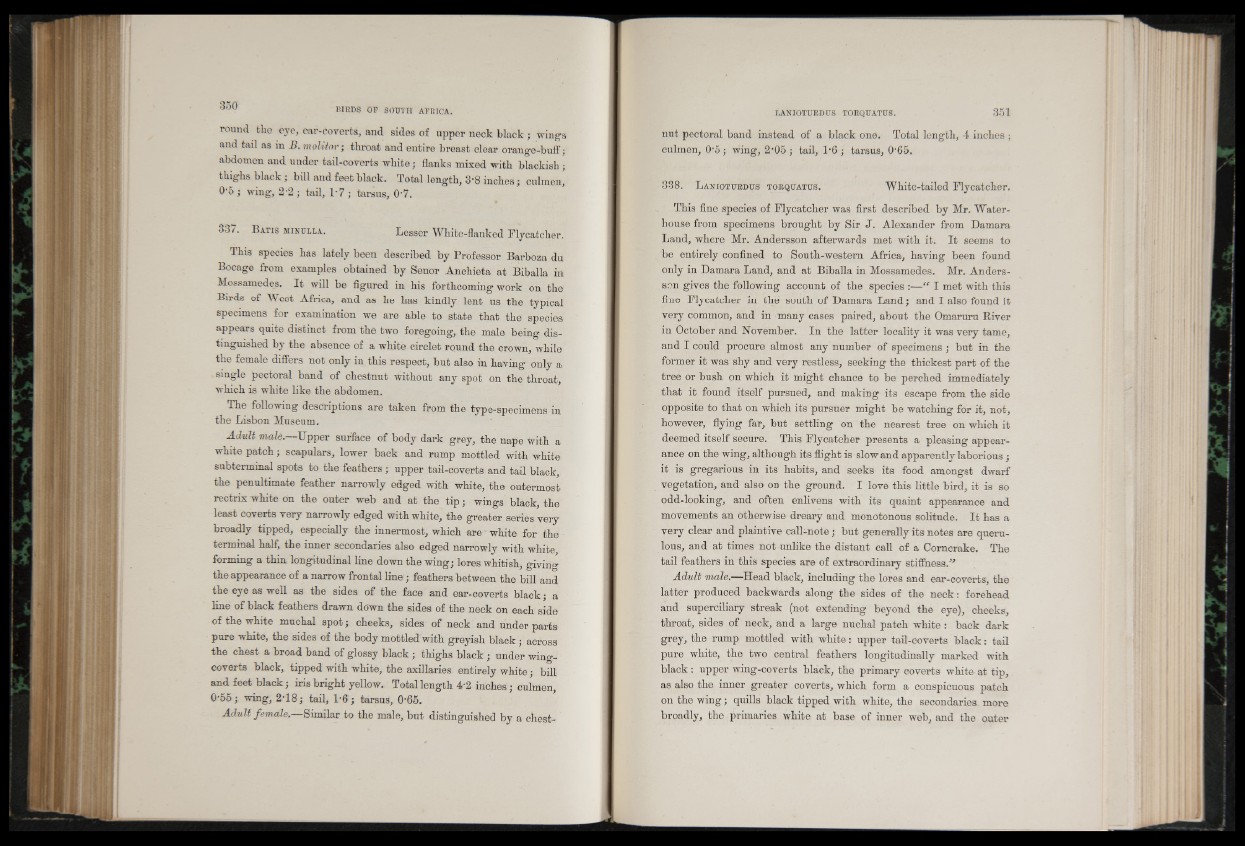
round the eye, ear-coverts, and sides of upper neck black ; wings
and tail as in B.molitnr; throat and entire breast clear orange-buff;
abdomen and under tail-coverts white; flanks mixed with blackish ;
thighs black; bill and feet black. Total length, 3'8 inches; culmen,
0'5 ; wing, 2'2 j tail, 1’7 ; tarsus, 07.
837. B atis h in u l l a . Lesser White-flanked Flycatcher.
This species has lately been described by Professor Barboza du
Bocage from examples obtained by Senor Anchieta at Biballa in
Mossamede_s. I t will be figured in his forthcoming work on the
Birds of West Africa, and as he has kindly lent us the typical
specimens for examination we are able to state that the species
appears quite distinct from the two foregoing, the male being dis-
tinguished by the absence of a white circlet round the crown, while
the female differs not only in this respect, but also in having only a
single pectoral band of chestnut without any spot on the throat,
which is white like the abdomen.
The following descriptions are taken from the type-specimens in
the Lisbon Museum.
Adult male. Upper surface of body dark grey, the nape with a
white patch; scapulars, lower back and rump mottled with white
snbterminal spots to the feathers ; upper tail-coverts and tail black,
the penultimate feather narrowly edged with white, the outermost
rectrix white on the outer web and at the tip ; wings black, the
least coverts very narrowly edged with white, the greater series very
broadly tipped, especially the innermost, which are white for the
terminal half, the inner secondaries also edged narrowly with white
forming a thin longitudinal line down the wing; lores whitish, giving
the appearance of a narrow frontal line; feathers between the bill and
the eye as well as the sides of the face and ear-coverts black; a
line of black feathers drawn down the sides of the neck on each side
of the white muchal spot; cheeks, sides of neck and under parts
pure white, the sides of the body mottled with greyish black; across
the chest a broad band of glossy black; thighs black; under wing-
coverts black, tipped with white, the axillaries entirely white; bill
and feet black; iris bright yellow. Total length 4-2 inches; culmen,
0-55; wing, 2'18; tail, 1-6 ; tarsus, 0-65.
Adult female.—Similar to the male, but distinguished by a chestnut
pectoral band instead of a black one. Total length, 4 inches ;
culmen, 0 5 ; wing, 2'05; tail, 1*6; tarsus, 0'65.
338. L anio tu bd us torquatus. White-tailed Flycatcher.
This fine species of Flycatcher was first described by Mr. Waterhouse
from specimens brought by Sir J. Alexander from Damara
Land, where Mr. Andersson afterwards met with it. It seems to
be entirely confined to South-western Africa, having been found
only in Damara Land, and at Biballa in Mossamedes. Mr. Andersson
gives the following account of the species :—“ I met with this
fine Flycatcher in the south of Damara Land; and I also found it
very common, and in many cases paired, about the Omaruru River
in October and November. In the latter locality it was very tame,
and I could procure almost any number of specimens ; but in the
former it was shy and very restless, seeking the thickest part of the
tree or bush on which it might chance to be perched immediately
that it found itself pursued, and making its escape from the side
opposite to that on which its pursuer might be watching for it, not,
however, flying far, but settling on the nearest tree on which it
deemed itself secure. This Flycatcher presents a pleasing appearance
on the wing, although its flight is slow and apparently laborious ;
it is gregarious in its habits, and seeks its food amongst dwarf
vegetation, and also on the ground. I love this little bird, it is so
odd-looking, and often enlivens with its quaint appearance and
movements an otherwise dreary and monotonous solitude. I t has a
very clear and plaintive call-note ; but generally its notes are querulous,
and at times not unlike the distant call of a Corncrake. The
tail feathers in this species are of extraordinary stiffness.”
Adult male.—Head black, including the lores and ear-coverts, the
latter produced backwards along the sides of the neck: forehead
and superciliary streak (not extending beyond the eye), cheeks,
throat, sides of neck, and a large nuchal patch white : back dark
grey, the rump mottled with white: upper tail-coverts black: tail
pure white, the two central feathers longitudinally marked with
black: upper wing-coverts black, the primary coverts white at tip,
as also the inner greater coverts, which form a conspicuous patch
on the wing; quills black tipped with white, the secondaries more
broadly, the primaries white at base of inner web, and the outer